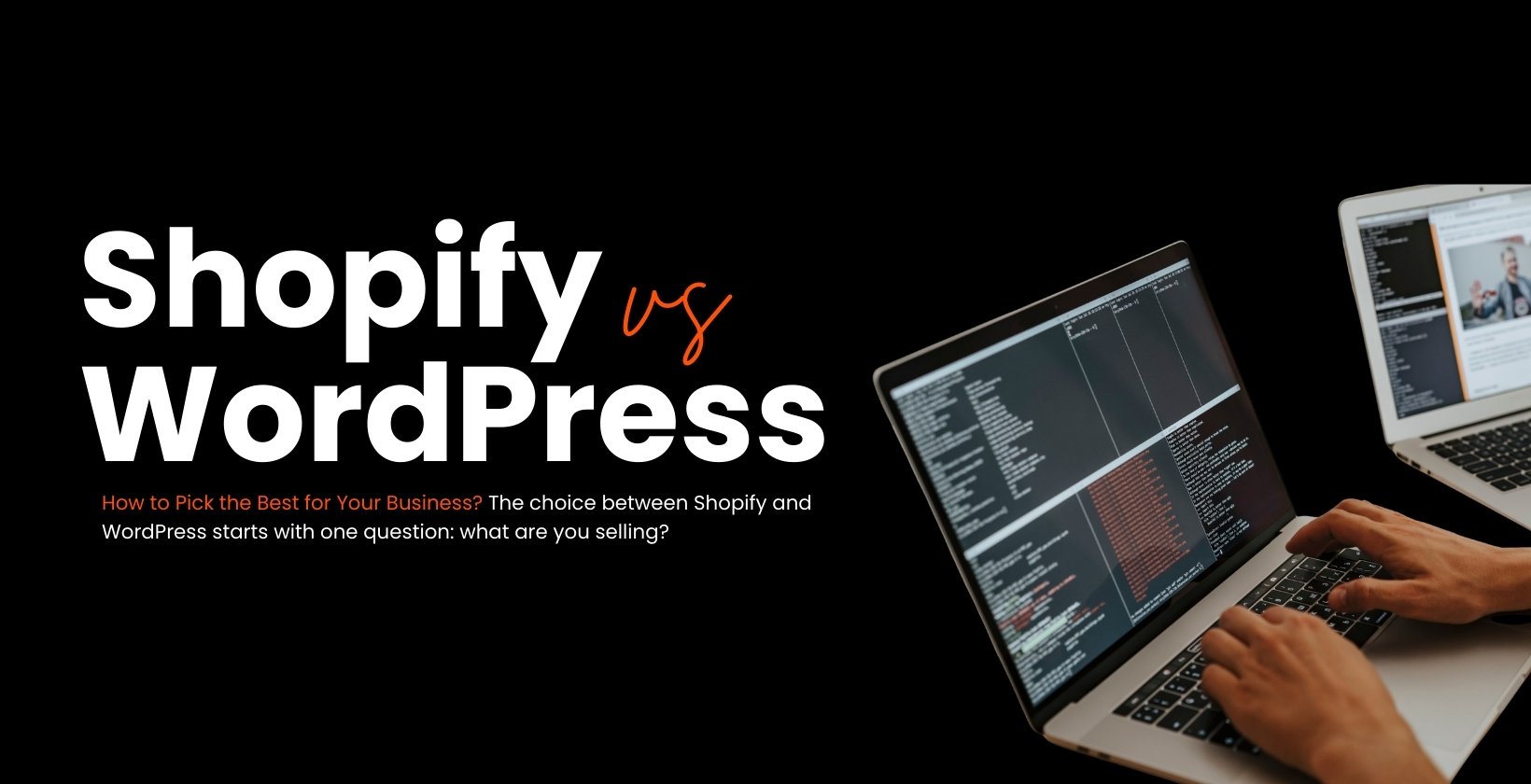The choice between Shopify and WordPress starts with one question: what are you selling? Your revenue model dictates the platform that will help you launch faster, convert more customers, and scale without the need for costly replatforming.
If your business runs on physical products, Shopify is purpose-built for ecommerce. It comes with hosting, payments, and inventory tools already in place. Shopify’s checkout process is easier for most customers, making it the best value for money when speed and sales efficiency are the priority.
If you sell services, publish content, or deliver digital products, WordPress with WooCommerce offers greater flexibility and functionality. You’ll manage hosting and updates, but gain unmatched technical SEO control and more platform choices for long-term growth.
At LAPR, we connect platform capabilities directly to business models, so you choose a system aligned with how you earn revenue.
Table of Contents
ToggleShopify vs WordPress: Quick Comparison by Business Model
Your business model is the clearest signal of which platform will support long-term growth. Product sellers need fast setup and scalable sales tools. Service providers and content-driven businesses need flexibility, SEO control, and design freedom. This table combines practical specifications with business-model fit, allowing you to see the trade-offs clearly.
| Factor | Shopify | WordPress (with WooCommerce) | Best Fit |
| Setup Speed | Turnkey, hosted, no coding | Requires hosting, domain, and plugin setup | Shopify → retailers who need fast launch |
| Ecommerce Tools | Built-in checkout, inventory, shipping | Requires WooCommerce + extensions | Shopify → physical product sellers |
| Customization | Theme-limited, app-based | Full code, design, and backend control | WordPress → service & content brands |
| SEO Control | Good basics, limited structure | Advanced SEO: taxonomies, schema, URLs | WordPress → SEO-driven businesses |
| Learning Curve | Beginner-friendly dashboard | Steeper, more technical setup | Shopify → first-time sellers |
| Starting Price | From $29/mo (Basic) | Hosting from $3-$5/mo, WooCommerce free | WordPress → budget-conscious startups |
| Transaction Fees | 2.9% + 30¢ online, 2.7% in-person (Shopify Payments) | ~2.9% + 30¢ via Stripe/PayPal, often 2.6% + 10¢ in-person | Comparable |
| Apps & Extensions | ~8,000 apps in App Store | ~820 WooCommerce extensions | Shopify → wider integrations |
| Trial / Free Option | 3-day free trial | Free to install (hosting costs apply) | WordPress → lower entry cost |
| Storage / Hosting | Unlimited storage, bandwidth | Depends on hosting (common ~50GB) | Shopify → no hosting limits |
| Support | 24/7 live support, managed hosting | Community forums + third-party devs | Shopify → non-technical teams |
| Business Model Fit | DTC brands, multichannel retailers, inventory-based sellers | Content-first, service providers, digital creators | – |
When Shopify Is the Best Choice for Physical Product Sellers
Shopify is optimized for inventory-led ecommerce businesses that rely on fast fulfillment and clear visibility into stock. Its platform bundles hosting, payments, and logistics, but the real advantage comes from native tools that automate inventory, streamline daily management, and expand sales into new channels. Shopify’s out-of-the-box inventory, checkout, and shipping tools eliminate plugin reliance, letting sellers launch with enterprise-grade features from day one. This integration makes Shopify the strongest fit for product sellers who need efficiency at scale.
Inventory, Shipping, and Fulfillment Features
Shopify automates operational workflows so product-focused SMBs can scale without custom systems. Its tools streamline order processing and provide real-time inventory visibility across every channel.
- Real-time inventory syncing prevents overselling across online and in-store sales.
- Shipping label generation automates packaging and dispatch from the admin.
- Multi-location fulfillment manages stock across warehouses for faster delivery.
- Delivery rate automation calculates live shipping costs to reduce cart abandonment.
Unified Dashboard for Store Management
The Shopify admin dashboard acts as a single control panel for ecommerce operations, replacing the need for multiple apps.
- Product management: Add, edit, and organize SKUs and collections.
- Order tracking: Monitor your fulfillment status in real-time.
- Customer segmentation: Group buyers by behavior, geography, or purchase history.
- Analytics reporting: Track revenue, conversion rates, and traffic sources.
Expanding Channels with Shopify App Ecosystem
Shopify enables sellers to reach customers where they already shop through built-in multichannel integrations. The Shopify App Store extends these options, supporting scalable growth.
- Facebook Shop: Sync products for direct in-platform purchases.
- Instagram Shopping: Tag products in posts and stories to boost mobile sales.
- POS system: Unify in-store and online sales with shared inventory.
- Google Shopping: List products across Google surfaces for a wider reach.
Why WordPress Suits Service, Content, and Digital Product Brands
WordPress is designed for content-led and service-driven businesses that rely on publishing, lead capture, or gated digital experiences. Its flexibility allows you to build custom workflows, monetize through WooCommerce, and maintain complete control over design and branding. This makes WordPress the strongest fit for creators, consultants, and agencies that need more than a checkout page.
Workflow Support for Service-Based Businesses
WordPress enables flexible user journeys for service brands without locking them into rigid templates. From capturing leads to booking consultations, it supports workflows that match your business process.
- Contact forms: Capture inquiries with custom fields and logic.
- Calendar plugins: Allow clients to book services or consultations online.
- CRM integrations: Connect form data to lead nurturing workflows.
- Gated resources: Deliver downloadable content in exchange for user data.
How WooCommerce Supports Mixed Content-Commerce Models
WooCommerce expands WordPress into a hybrid commerce platform for digital products, memberships, and service upsells. It allows you to monetize without disrupting a content-first architecture.
- Content-gated sales: Sell access to premium articles, videos, or downloads.
- Upsells from blog posts: Promote services or products inside editorial content.
- Mixed product types: Offer services, digital downloads, and subscriptions in one storefront.
This flexibility makes WooCommerce ideal for creators who want to publish and sell on the same platform.
WordPress Flexibility for Design-Heavy, Content-First Brands
WordPress gives complete control over visual identity and user experience, supporting brands where design carries as much weight as content.
- Dynamic content blocks: Tailor layouts for different pages and audiences.
- Theme builders like Elementor and Bricks: Enable no-code, drag-and-drop design.
- Advanced CSS customisation: Align every visual element with brand guidelines.
- Reusable components: Maintain consistency across pages and templates.
- Custom theme frameworks: Create scalable, fully bespoke front-end structures.
This level of customization supports creative direction without compromising performance or scalability.
Shopify vs WordPress Pricing: Total Cost Breakdown by Business Type
Pricing for Shopify vs WordPress reflects two different models. Shopify uses tiered monthly plans with bundled hosting and ecommerce tools, while WordPress is modular—costs depend on hosting, plugins, and developer support. The real difference shows up when scaling: predictability with Shopify versus flexibility with WordPress.
Shopify Pricing Breakdown for Product Sellers
Shopify’s pricing scales in tiers, bundling hosting, payments, and security into each plan. This creates predictable growth paths for product sellers.
| Shopify Plan | Key Benefits & Costs |
| Basic ($25/mo) | Core selling tools, 2 staff accounts, basic support |
| Grow ($65/mo) | Advanced reporting, up to 5 staff, reduced transaction fees |
| Advanced ($399/mo) | Deeper analytics, up to 15 staff, lowest Shopify fees |
| Plus ($2,300/mo) | Enterprise features, custom checkout, priority support |
Shopify Payments sets transaction fees at 2.9% + 30¢ online and 2.7% in-person. Alternative gateways add extra costs, while WordPress with Stripe/PayPal averages ~2.9% + 30¢ or 2.6% + 10¢ in-person. Add-ons such as apps and premium themes increase total spend but extend functionality.
WordPress Cost Structure for Service Brands
WordPress itself is free, but scaling requires add-ons and maintenance. Service-driven brands value this flexibility, but budgets must account for modular costs:
- Hosting: $5-$30/month, depending on performance needs
- Premium themes: $50-$100/year for advanced design and branding flexibility
- Plugin licenses: $50-$300/year for SEO, booking, or performance features
- Security & backups: $50-$150/year for essential protection and uptime monitoring
- Maintenance or developer support (optional): Hourly or retainer for site upkeep
This modular cost structure gives WordPress an edge in flexibility but requires more proactive budgeting and oversight compared to Shopify’s bundled pricing model.
Ownership Costs and Hidden Expenses Compared
Pricing goes beyond published plans. Real ownership costs emerge as your site scales, and they differ sharply between Shopify and WordPress.
- Shopify: Paid apps for SEO or subscriptions, transaction fees (unless using Shopify Payments), and premium themes. Over time, reliance on multiple apps often leads to subscription creep, resulting in increased monthly spending.
- WordPress: Annual plugin and theme renewals, hosting fees that rise with traffic, separate billing for security tools, and developer costs for updates. These costs are less predictable but more controllable, depending on the extent of customization.
Understanding these hidden expenses is essential to calculating the total cost of ownership (TCO), not just entry-level pricing.
LAPR’s Framework for ROI by Business Model
At LAPR, we measure platform costs against long-term return, not just startup savings. Our ROI framework connects pricing structures to business models:
| Business Type | Platform Fit + Reasoning |
| Local Service Brand | WordPress → flexible lead-gen workflows with lower recurring costs |
| Product-First DTC | Shopify → built-in inventory, payments, and multichannel sales tools speed revenue cycles |
| Hybrid Creator Model | WordPress → supports gated content, memberships, and diverse digital offerings |
| Subscription Brand | Shopify → native apps for recurring billing and fulfillment workflows |
| Agency or Consultant | WordPress → greater control over branding, content structure, and SEO visibility |
This ROI-first approach reframes the decision: Shopify delivers predictable scalability, while WordPress offers cost flexibility with customization control. We help businesses choose the model that protects margins and fuels growth.
Shopify vs WordPress SEO: Which Platform Drives Better Visibility?
SEO determines how easily customers discover your business. In the Shopify vs. WordPress SEO comparison, Shopify streamlines optimization for product pages, while WordPress gives advanced control for content-led strategies. The platform you choose shapes not just rankings, but long-term visibility.
How Shopify Handles SEO for Product-First Brands
Shopify’s SEO features are designed to help retailers get indexed quickly, even without technical expertise. Automation keeps product catalogs visible and avoids common errors.
- Automatic sitemaps and 301 redirects maintain clean URLs and preserve rankings during updates.
- Mobile-optimized themes deliver fast, responsive experiences that boost mobile SEO.
- Editable meta titles and descriptions enable basic keyword targeting.
- Structured data and canonical tags help search engines interpret product content.
For DTC and multichannel sellers, these features provide reliable SEO foundations with minimal configuration.
How WordPress Supports Content-Led SEO Strategies
WordPress excels when growth depends on content authority. Plugins like Yoast and Rank Math enable granular optimization beyond product pages.
- Custom taxonomies structure content silos for stronger topical authority.
- Full access to robots.txt, permalinks, and schema, precise control over crawling and indexing.
- Theme-level optimization improves rendering speed and HTML cleanliness.
- Internal linking controls build semantic hierarchies across pages.
This flexibility makes WordPress especially effective for service providers and publishers competing on high-quality, content-driven SEO.
Technical SEO Factors: Structure, Speed, and Indexability
SEO performance also depends on infrastructure. Shopify and WordPress diverge sharply here:
| SEO Factor | Shopify | WordPress |
| Hosting Control | SaaS model, no server-level access | Full hosting control with the chosen provider |
| Page Speed | Fast by default with optimized themes | Variable; depends on hosting, theme, and plugins |
| CDN Integration | Built-in CDN on all plans | Requires a hosting plan or external integration |
| Plugin/Script Overhead | Minimal (limited extensibility) | Can be heavy; manageable with lightweight setups |
Shopify favors consistency and simplicity, while WordPress rewards hands-on optimization for maximum performance.
Design and UX: Which Platform Gives You More Visual Control?
Design in ecommerce comes down to three priorities: how fast you launch, how flexible your branding is, and how advanced your user experience needs to be. Shopify emphasizes speed with ready-made templates, while WordPress gives full creative freedom for brands where design is central.
Shopify Templates: Fast to Launch, Limited in Customisation
Shopify themes accelerate launch timelines but trade flexibility for simplicity.
- Rigid layouts: Restrict advanced custom page structures.
- Limited CSS access: Reduces ability to fine-tune visuals.
- App-based UI extensions: Add features but risk design inconsistency.
- Preset theme controls: Confine branding to predefined settings.
For product sellers focused on speed, Shopify provides conversion-ready designs that work out of the box.
WordPress Themes: Flexible for Complex Visual Branding
WordPress themes and builders provide design-driven brands with the freedom to match visuals with user flows.
- Dynamic content blocks: Adapt layouts by page or audience.
- Conditional logic: Personalize elements by user behavior.
- Advanced CSS: Enforce strict brand guidelines.
- Reusable components: Maintain design consistency at scale.
This flexibility makes WordPress ideal for content-first or creative businesses that compete on brand identity.
Choosing a Platform Based on Your Design Priorities
The right platform depends on which of the three design priorities from above drives your business.
| Design Priority | Recommended Platform | Why |
| Speed to launch | Shopify | Pre-built templates deliver fast deployment |
| Custom visuals | WordPress | Provides granular branding and layout control |
| Interactive UX | WordPress | Supports dynamic elements and personalized flows |
Shopify serves brands where launch speed outweighs design depth. WordPress serves brands where creative control and complex UX shape the customer experience.
Platform Decision Framework Based on Stage, Goals, and Monetisation
The choice between Shopify and WordPress depends less on popularity and more on fit. Your team’s technical capacity, your site’s core function, and your revenue model each shape which platform will support growth with the least friction.
Technical and Scalability Considerations
Your team’s technical skill sets the foundation for choosing the right platform. A DIY entrepreneur needs simplicity, while a developer-led team can leverage control and efficiency.
- Shopify: Fully hosted, no server maintenance, automatic updates, and security.
- WordPress: Requires hosting setup, manual updates, and plugin compatibility management, but gives full backend access.
Beyond ease of setup, the underlying architecture determines the level of control you have over hosting, files, and databases.
Architecture snapshot
- Hosting model: Shopify = fully hosted (SaaS); WordPress = self-hosted (your provider).
- CMS type: Shopify = proprietary; WordPress = open-source.
- Database access: Shopify = no direct SQL; WordPress = full database access.
- File control: Shopify = limited to theme files; WordPress = full access to core, theme, and plugin files.
Ownership & responsibility
- Shopify: Bundles hosting, SSL, security, and updates into one package; uptime and patches are managed for you.
- WordPress: Requires choosing a host and handling performance, backups, and updates yourself; offers full control over servers and files.
Scalability here depends on whether you want to outsource complexity or manage it directly.
Content vs Commerce: Primary Platform Functions
Your site’s primary function—content publishing or commerce—determines which platform aligns best.
| Content Priority | Platform Match | Why |
| Blogging and SEO | WordPress | Rich content control and SEO plugins |
| High cart conversion | Shopify | Optimized checkout and ecommerce UX |
| Long-form content + sales | WordPress | Hybrid support for content-commerce flows |
| Pure product catalog | Shopify | Streamlined browsing and purchase flow |
This split ensures the platform reflects what your visitors value most: content depth or ease of buying.
Matching Business Model to Revenue Strategy
Your revenue model should shape platform choice. WordPress and Shopify align differently depending on how your business earns.
| Monetization Type | Platform Fit | Rationale |
| Service bookings | WordPress | Better for scheduling tools, lead funnels, and flexible pages |
| Digital product sales | WordPress | Supports content-gated delivery and multiple file types |
| Subscriptions / Memberships | Shopify | Native ecosystem for recurring billing and workflows |
| Physical product margins | Shopify | Built-in inventory, payments, and fulfillment |
| Multi-offer / hybrid models | WordPress | Greater flexibility for blending services, content, and commerce |
This framework matches how you earn revenue to the platform that sustains it, ensuring long-term ROI without technical bottlenecks.
Platform Fit by Industry: Shopify vs WordPress Use Cases
Different industries have different operational demands. Shopify fits inventory-heavy sectors like retail and DTC, where fulfillment speed and checkout efficiency drive growth. WordPress suits service providers, agencies, and digital-first brands that prioritize lead generation, flexible workflows, or content delivery. A matching platform to your industry ensures the technology supports, not limits, your core business model.
Shopify for Retail, DTC, and Inventory-Based Models
Retail and direct-to-consumer brands need reliable stock control and frictionless checkout. Shopify bundles these essentials into its core system.
- Inventory sync: Keeps product availability accurate across online and in-store channels.
- Shipping calculators: Display real-time delivery rates to reduce cart abandonment.
- Product categorization: Organizes large catalogs for faster navigation.
- Customer accounts: Support repeat purchases and personalized shopping.
Shopify reduces operational complexity, allowing retailers to scale product sales quickly.
WordPress for Coaches, Agencies, and Local Services
Service-driven businesses rely on visibility and client workflows. WordPress provides the flexibility to design those flows without platform restrictions.
- Flexible forms: Capture leads, inquiries, or service requests.
- Scheduling plugins: Enable online appointment booking and calendar sync.
- SEO landing pages: Improve rankings for local or niche queries.
- Custom templates: Deliver branded, conversion-focused layouts.
This structure helps service businesses attract, convert, and retain clients efficiently.
WordPress + LMS for Creators and Digital Courses
Educators and creators need secure, scalable platforms for delivering courses and memberships. WordPress, combined with LMS plugins, offers tailored solutions.
| LMS Plugin | Use Case |
| LearnDash | Full-featured courses with quizzes and drip content |
| LifterLMS | Memberships, subscriptions, and gated learning paths |
| Tutor LMS | Multimedia-rich lessons with certificates and reports |
| MemberPress LMS | Tiered course access with recurring billing |
This flexibility allows digital educators to grow communities and monetize knowledge on one platform.
Platform Fit for Subscriptions, Tiered Access, Multi-Offer Models
Subscription and hybrid businesses demand flexible billing and content control. Shopify simplifies setup but limits depth, while WordPress supports complex access structures.
| Model | Shopify | WordPress |
| Subscriptions | Supports recurring payments via apps (e.g., Recharge) | Full control with plugins like MemberPress or WooCommerce Subscriptions |
| Membership access | Basic features via third-party apps | Advanced tiered access and gated content |
| Mixed sales models | Limited flexibility across products, services, and content | Ideal for hybrid offerings (e.g., services + downloads + communities) |
Shopify accelerates launch, but WordPress enables greater customization for complex subscription models.
How LAPR Recommends Platforms Based on Strategy, Not Preference
At LAPR, platform recommendations aren’t based on trends or personal bias. We evaluate every client’s business model, scalability goals, and monetization path, then map platform fit to ROI potential, operational efficiency, and tech stack compatibility. This approach ensures the platform supports growth instead of creating future replatforming costs.
Case Example: Why LAPR Recommended Shopify for a DTC Skincare Brand
In our platform assessments, we’ve seen DTC skincare brands struggle with slow load times, limited checkout options, and weak mobile performance on legacy platforms. Inventory growth often outpaces backend systems, leading to lost conversions and rising support tickets.
When migrated to Shopify, these brands benefit from real-time inventory synchronization, optimized mobile checkout, and multichannel integrations, such as Instagram and Google Shopping. Results often include measurable improvements, such as higher checkout conversions, lower cart abandonment rates, and significant revenue growth, clear indicators that Shopify aligns with product-first models.
Case Example: Why LAPR Chose WordPress for a Service-Led Website
We’ve also seen service-led businesses, such as coaching firms, reach growth limits with templated sites. Without scalable content marketing, lead capture, or flexible booking, visibility and conversion rates remain stagnant.
By migrating to WordPress and implementing a content-first SEO strategy with custom booking workflows, these businesses typically achieve lower bounce rates, increased qualified leads, and higher organic visibility, demonstrating why WordPress supports service-driven growth more effectively than rigid platforms.
How LAPR Prevents Replatforming Through Strategic Audits
Switching platforms too often is costly, both financially and in lost SEO equity. To prevent this, we run comprehensive audits before making any recommendations.
Key criteria in our audit framework:
- Scalability: Can the platform handle growing products, services, and team size?
- SEO control: Does the CMS allow technical + on-page flexibility?
- Monetization model: Are features aligned with how revenue is earned?
- Tech stack compatibility: Will it integrate with CRM, analytics, and other tools?
This audit-first method reduces replatforming risks and ensures the platform choice aligns with long-term business outcomes.
FAQs: Shopify vs WordPress for Different Business Models
Which Platform Is Easier for Beginners Without a Developer?
Shopify is easier for beginners without a developer because setup, hosting, and design are built in. WordPress for beginners requires manual hosting, plugin configuration, and more technical knowledge before launching a functional ecommerce site.
Which One Integrates Better With Print-on-Demand Apps?
Shopify integrates more effectively with print-on-demand apps because it offers native integrations with Printful and Gelato, automated order syncing, and simplified fulfillment. WordPress integrations are available, but they typically require WooCommerce extensions and more manual setup compared to Shopify.
Which Platform Offers the Best Mobile UX?
Shopify offers the best mobile UX because its themes are optimized for fast checkout and responsive design. WordPress mobile UX depends on theme choice, plugins, and hosting, making it less consistent than Shopify’s ecommerce-focused mobile experience.
Are Shopify and WordPress Secure for Online Payments?
Yes, Shopify and WordPress are secure for online payments, but Shopify’s security is managed with built-in PCI compliance. WordPress security requires plugins, SSL certificates, and proper configuration, making Shopify simpler, while WordPress offers more customizable protection.
Can I Combine WordPress and Shopify on One Site?
Yes, you can combine WordPress and Shopify on the same site by embedding Shopify’s Buy Button or utilizing headless commerce integrations. This setup suits content-heavy WordPress sites that also need Shopify’s reliable ecommerce and checkout system.
Choose the Right Platform: Map Shopify or WordPress to Your Business Goals
The best platform is the one that aligns with your business model, revenue strategy, and growth goals, not just software features. In short, Shopify suits businesses prioritizing speed, simplicity, and managed hosting, while WordPress fits brands seeking flexibility, advanced SEO, and full control. Your budget and technical skills decide the fit. At LAPR, we evaluate those factors through a structured ecommerce platform audit, helping you avoid costly replatforming and build on the right foundation from day one.
Request your custom ecommerce platform assessment today and choose Shopify or WordPress with confidence.





